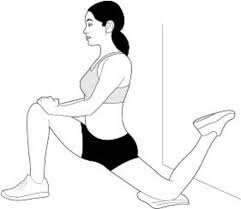
Britta Pederson works with a client using resistance bands. Photo by Sally Spickard.
There’s no getting around it: riding is tough on the body. As with any sport, the wear and tear brought about by the physical exertion as well as any injuries that may occur can wreak havoc on even the healthiest rider. But ask any rider what comes first: horse care or self-care, and you can predict what their answer will be. All too often, we neglect the wellness of our own bodies and minds in favor of that of our horses. Britta Pederson of The Performance Refinery in San Diego, Ca. is out to change this notion.
Take a moment to think of the physical irregularities that show up in your riding. Perhaps you struggle to keep your shoulders down and back, or you can’t seem to weight the right seat bone as well as you can the left. Now think of how these might transfer to your horse’s way of going. As with riding a bike, any shift in balance on the part of the rider can affect the straightness and direction of the horse.
Q&A: What can I expect in an Equiformance S.M.A.R.T Rider Clinic with Britta … ???
➖
👀 Full On & Off Horse…Posted by The Performance Refinery on Tuesday, December 1, 2020
When riders attend a clinic with Britta, a Registered Senior Physiotherapist & Equestrian specific Performance Trainer from New Zealand who has also competed at the Advanced level of eventing and Grand Prix level of dressage, they’ll experience a hybrid format, one part riding instruction and one part bodywork.

Britta takes a teaching break to work on a student’s weak points. Photo by Sally Spickard.
“The notion of taking care of our horses’ bodies is important, but this doesn’t mean you should set yourself aside,” Britta explained. In order to effectively correlate our body’s function to our riding, Britta incorporates basic anatomy into her instruction. She’s also patented the concept of using resistance bands to encourage lengthening of a rider’s body and proper application of the aids while working on the flat – a topic we’ll dive deeper into in a future article.
Britta works with each rider individually to identify their physical strengths and weaknesses, astutely pinpointing a source of a problem and working to correct the issue through physical therapy.
But first, it’s important to know where you need to improve and how riding affects your body. Generally speaking, Britta says, a lot of rider issues stem from the following areas:
Weak Core Stabilizers
These could one or a combination of any of the following: Lower Abdominals/Obliques/Glutes/Mid Back
In today’s society and the nature of our sport we spend a vast amount of time, both in and out of the saddle, in anterior chain-dominant positions. Think mucking stalls, wrapping legs, jump schooling in two-point (hello hip flexion), replying to emails, and working from home online behind your workstation.
“One fairly simple way that we can combat these demands placed on our bodies is by making sure that we are as stable as possible from our innermost core levels,” Britta says. “This takes a little bit of thought and assessment of where your weak areas are and then putting a plan in place. Core stability work should only take up two or three days and 20-30 minutes of your time … and you can get creative, meaning minimal equipment required. A Stability Ball will be your best friend as it can see all levels of core training from beginner to advanced.”
Some Level 1 & 2 exercise ideas for core conditioning:
Poor Hip Mobility
Restricted Hip Joints are a common complaint and pathology that Britta often sees in the clinic setting. “If you have poor range of movement here it will affect your global musculature activation and ability to move your pelvic girdle efficiently over fences,” she explains. “A ‘stuck’ pelvis can limit your lower leg effectiveness and indirectly your balance.”
To test your own body, try this Hip Mobility Test and Drill:
Overactive Quads & Psoas (Hip Flexors) & Short Adductors
“One of the main muscle groups that are tight in jumpers, due to jumping positions and the eccentric control needed as a rider from your hips/legs to slow your body on landing, are your quadriceps and hip flexors,” Britta says. “If these become highly overactive, they can lead to lower back pain and poor core function. See the images below for good Hip Flexor (a), Quad (b) and short adductor stretches (c):
- Line drawing of man kneeling on one knee doing hip stretch. SOURCE: Based on EMuscsk_20131030_v0_006. Used in 901819, 90608, 90644_4 version in 13A12046.
Another element of The Performance Refinery that riders find useful is Britta’s Equiformance Program for fitness. Fitness is a key element of success in the saddle – much of a rider’s ability relies on core strength as well as upper and lower body stability in order to effectively apply aids. After the coronavirus pandemic surged this year, Britta doubled down on her efforts to expand the Equiformance Program, making use of a dedicated app to create and distribute customized workout plans. Each plan is tailored to the athlete’s goals, schedule, and level of training, with workouts that can be done with minimal or no gym equipment needed.
In the coming weeks, we’ll be diving in deeper with Britta to explore the concept of rider biomechanics and fitness – and her innovative training method using resistance bands. We’ll also bring you some additional content with exercises you can do out of the saddle as well as some advice for making 2021 your best fitness year yet.





















